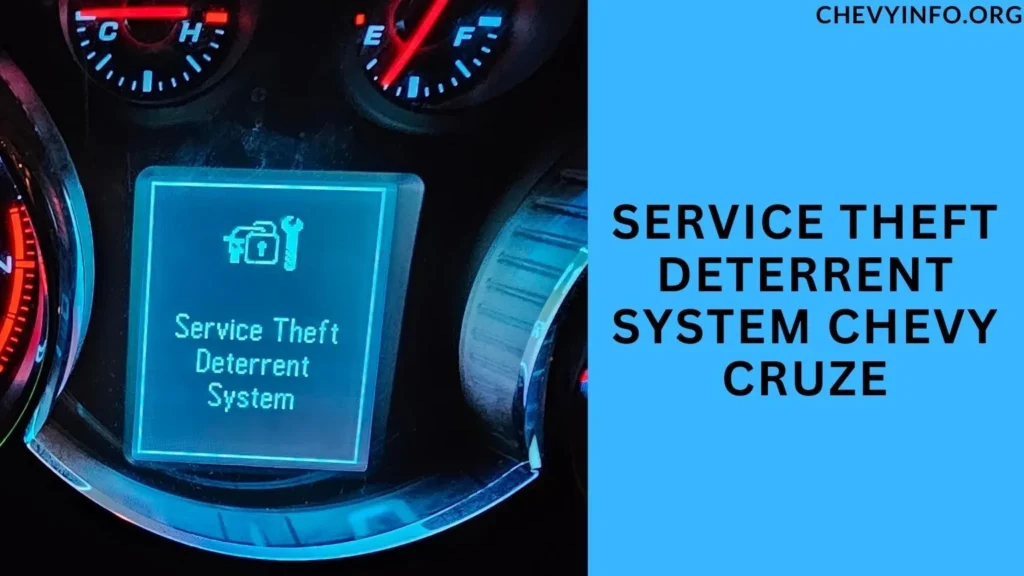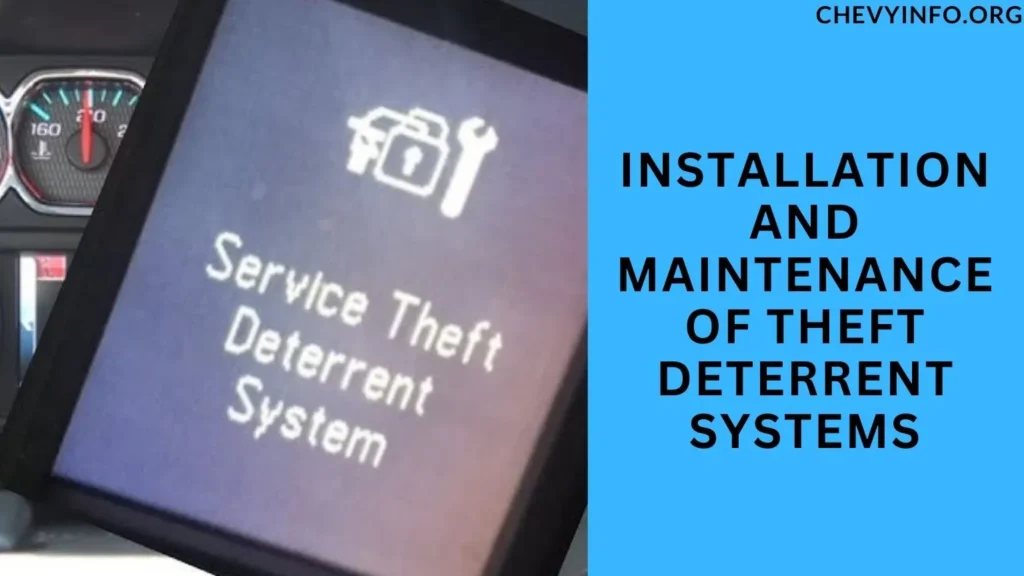Service Theft Deterrent System Chevy Cruze
As car theft continues to be a prevalent concern, especially in urban areas, the need for robust security measures has become paramount.
Service Theft Deterrent System Chevy Cruze, One such measure gaining popularity among vehicle owners is the service theft deterrent system for Chevy Cruze and similar models.
This article delves into the significance of these systems, their types, features, installation, effectiveness, cost considerations, and future trends.

Introduction to Theft Deterrent Systems
Before diving into specifics, it’s crucial to understand what theft deterrent systems entail. Essentially, these systems are designed to prevent unauthorized access and theft of vehicles.
They employ a range of technologies and mechanisms to deter potential thieves and provide peace of mind to car owners.
Importance of Service Theft Deterrent System Chevy Cruze
Recent data reveals a concerning rise in car theft incidents, making it imperative for Chevy Cruze owners to invest in reliable security solutions.
Studies show that vehicles equipped with theft deterrent systems are significantly less likely to be stolen compared to those without such protections.
Types of Theft Deterrent Systems
There are two primary types of theft deterrent systems: factory-installed and aftermarket. Factory-installed systems come pre-installed by the manufacturer and are often integrated with the vehicle’s electronics.
On the other hand, aftermarket systems are installed post-purchase and offer customizable features based on the owner’s preferences.
Here are some common types of theft deterrent systems:
- Factory-Installed Systems: These systems come pre-installed by the vehicle manufacturer and are integrated into the vehicle’s electronics. They often include features such as remote keyless entry, immobilizers, and alarm systems. Factory-installed systems are designed to work seamlessly with the vehicle’s overall security architecture.
- Aftermarket Alarm Systems: Owners can install aftermarket alarm systems as additional security measures. These systems typically include loud alarms, flashing lights, and sensors that detect unauthorized entry or tampering. They can be customized based on the owner’s preferences and security needs.
- Immobilizers: Immobilizers are anti-theft devices that prevent the engine from starting unless the correct key or key fob is used. They work by sending a signal to the vehicle’s electronic control unit (ECU) to authorize engine ignition. Without the correct authorization, the engine remains immobilized, thwarting theft attempts.
- GPS Tracking Systems: GPS tracking systems use global positioning technology to track the location of the vehicle in real-time. In the event of theft, these systems enable owners and authorities to track and recover the stolen vehicle quickly. Some GPS tracking systems also offer features like geo-fencing and remote engine shutdown.
- Steering Wheel Locks: Steering wheel locks are physical deterrents that prevent thieves from steering the vehicle even if they manage to start the engine. These locks attach to the steering wheel, making it difficult or impossible to turn without the corresponding key or code.
- Smart Keys and Keyless Entry Systems: Modern vehicles often come equipped with smart keys and keyless entry systems that use encrypted codes to unlock doors and start the engine. These systems enhance security by making it challenging for thieves to duplicate or bypass key authentication.
- Vehicle Identification Number (VIN) Etching: VIN etching involves permanently engraving the vehicle’s VIN on its windows and major components. This not only deters theft but also aids in vehicle identification and recovery if stolen.
- Electronic Vehicle Immobilization Systems: These systems use electronic circuits to immobilize specific vehicle functions, such as fuel injection or ignition, in response to unauthorized access attempts. They add an extra layer of security beyond traditional mechanical locks.
- Motion Sensors and Proximity Alarms: Motion sensors detect movement around the vehicle, triggering alarms to alert nearby individuals or security systems. Proximity alarms activate when someone gets too close to the vehicle without proper authorization, deterring potential thieves.
- Biometric Security Systems: Advancements in technology have introduced biometric security systems that use fingerprint, facial recognition, or voice recognition technologies to authenticate vehicle access. These systems offer highly secure authentication methods against theft attempts.
Features of Chevy Cruze Theft Deterrent System
The theft deterrent system in Chevy Cruze boasts advanced features such as remote keyless entry, immobilizers, alarm systems, and GPS tracking.
These technologies work cohesively to safeguard the vehicle and alert the owner or authorities in case of suspicious activities.
Installation and Maintenance of Theft Deterrent Systems

While professional installation ensures optimal functioning, some owners opt for DIY installations.
Regardless of the method chosen, regular maintenance is essential to keep the system in top condition. Simple practices like checking batteries and updating software can enhance longevity.
Effectiveness of Theft Deterrent Systems
Numerous success stories highlight the effectiveness of theft deterrent systems. From thwarting theft attempts to aiding in vehicle recovery, these systems have proven their worth in real-world scenarios, earning the trust of Chevy Cruze owners worldwide.
Cost Considerations
Cost is between $132 and $143, The initial investment in a theft deterrent system is a worthwhile expense considering the potential losses incurred in the event of theft.
Moreover, many insurance providers offer discounts for vehicles equipped with such security measures, offsetting the initial cost over time.
Future Trends in Theft Deterrent Technology
As technology evolves, theft deterrent systems are expected to become more sophisticated. Advancements such as biometric authentication, AI-driven surveillance, and blockchain-based security protocols are on the horizon, promising even greater protection for vehicle owners.
People also ask
How do you fix the service theft deterrent system on a Chevy Cruze?
To fix the service theft deterrent system on a Chevy Cruze, follow these steps:
Check Battery: Ensure the vehicle’s battery is fully charged and functioning properly. Weak or faulty batteries can cause issues with the theft deterrent system.
Inspect Key Fob: Check the key fob for any damage or malfunction. Replace the battery in the key fob if necessary, and ensure it is synchronized with the vehicle.
Reset System: Try resetting the theft deterrent system by disconnecting the battery for a few minutes and then reconnecting it. This can sometimes resolve minor glitches.
Check Fuses: Inspect the fuses related to the theft deterrent system in the vehicle’s fuse box. Replace any blown fuses with the appropriate replacements.
Scan for Error Codes: Use a diagnostic tool to scan for error codes related to the theft deterrent system. Address any identified issues based on the error code descriptions.
Update Software: If possible, update the vehicle’s software or firmware to the latest version. Manufacturers often release updates to address bugs and improve system performance.
Professional Inspection: If the above steps do not resolve the issue, it’s advisable to seek professional help. A certified technician can perform a comprehensive inspection and diagnostics to accurately pinpoint and fix the problem.
Why did my service theft deterrent system come on?
Your service theft deterrent system may come on due to various reasons, including:
Key Fob Issues: A malfunctioning or low battery in your key fob can trigger the service theft deterrent system warning.
Electrical Problems: Issues with the vehicle’s electrical system, such as faulty wiring or blown fuses, can cause the system to activate.
Software Glitches: Occasionally, software glitches or bugs within the vehicle’s security system can lead to the service theft deterrent system warning.
Tampering Attempts: If there have been attempts to tamper with the vehicle or unauthorized access, it can activate the theft deterrent system.
System Calibration: Sometimes, the system may require recalibration or reprogramming, especially after battery replacements or maintenance.
How do I get my car out of theft deterrent mode?
To get your car out of theft deterrent mode, follow these steps:
Use the Correct Key: Ensure you are using the correct key or key fob that is programmed and recognized by the vehicle’s theft deterrent system.
Reset the System: Turn off the ignition and remove the key from the ignition switch. Wait for a few minutes, then reinsert the key and attempt to start the car again.
Check Battery: Ensure the vehicle’s battery is fully charged and in good condition. Weak batteries can sometimes trigger the theft deterrent mode.
Unlock Doors: Try unlocking and locking the doors using the key fob or the manual key. This action can sometimes reset the theft deterrent system.
Consult Owner’s Manual: Refer to your vehicle’s owner’s manual for specific instructions on how to reset or deactivate the theft deterrent mode, as methods can vary based on the car model and manufacturer.
How do you get a car out of anti-theft mode with a key Chevy Cruze?
To get a Chevy Cruze out of anti-theft mode use a key:
Turn Off Ignition: Turn off the ignition and remove the key from the ignition switch.
Wait: Wait for at least 10 minutes to allow the system to reset.
Insert Key: Reinsert the key into the ignition and turn it to the “ON” position without starting the engine.
Security Light: Watch for the security light on the dashboard. Once it stops flashing or turns off, start the engine.
Conclusion
In conclusion, the service theft deterrent system in Chevy Cruze is a vital asset in safeguarding vehicles and ensuring peace of mind for owners.
With its array of features, effectiveness, and future advancements, investing in such security measures is not just prudent but necessary in today’s automotive landscape.

Henry Worner, a seasoned automotive expert with over 13 years of experience in car repair, maintenance, and performance enhancement, ChevyInfo.org was born out of a passion for Chevrolet vehicles. Henry’s deep-rooted love for everything Chevy has driven him to create a platform where fellow enthusiasts, car owners, and anyone interested in Chevy cars can find valuable insights, tips, and guidance.






